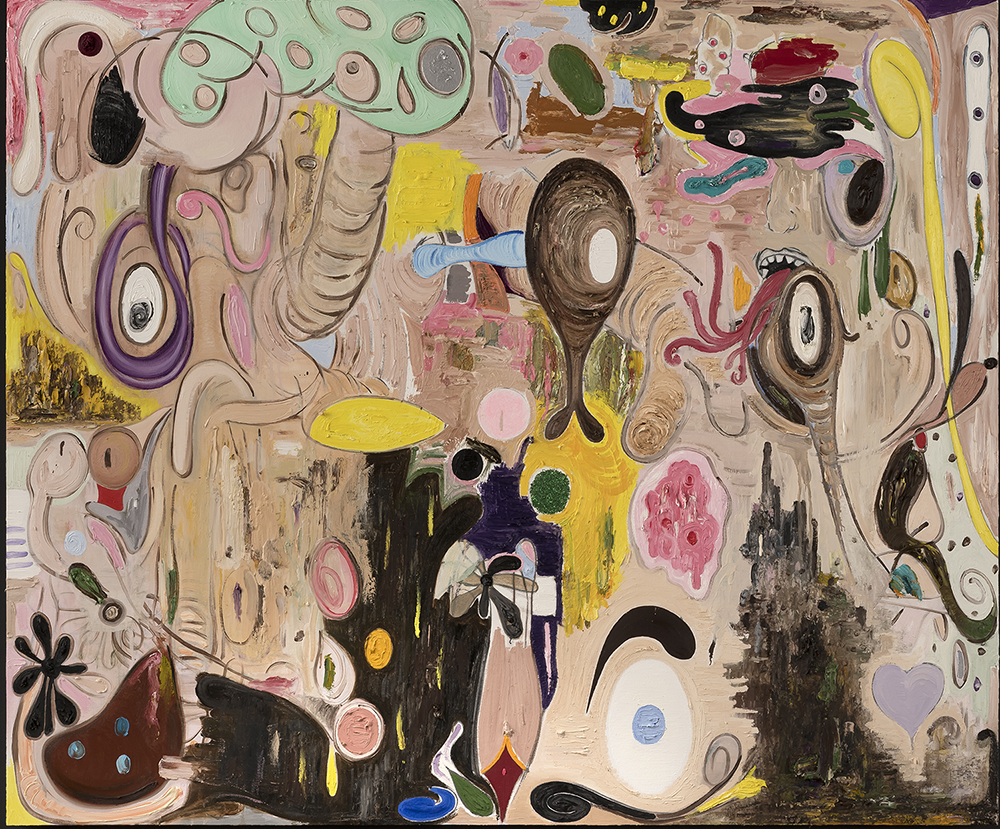Victor Estrada erupted onto the art world landscape with his confounding work in the 1992 Los Angeles MOCA exhibition, “Helter Skelter: L.A. Art in the 1990s,” along with other luminaries such as Harry Gamboa Jr., Megan Williams and Mike Kelley. What’s mystifying is that a broader examination of his work has been elusive—until now. The current exhibition at his alma mater, ArtCenter, is evidence that he’s continued creating works that both perplex and intrigue; it’s a startling corpus of images and media. Curated by Marco Rios, the purple-and-pink walled show’s overwhelming sensorial impact is extraordinarily confident.
Estrada, with roots in Los Angeles and El Paso, Texas, was active in the early social justice movements such as MECha (Movimiento Estudiantil Chicano de Aztlán), and later turned his focus to community teaching and, currently, instructing at UCLA. The exhibit’s title, “Victor Estrada: Purple Mexican,” is a deliberative cue that takes its nods from the hue’s lofty ascriptions: purple, an unstable color that exists somewhere between red and blue and has long been associated with royalty. But its contemporary alliteration also refers to the purportedly hallucinogenic properties of purple-branded marijuana; not unlike like its legendary pharmacological cousins. Its mythos was famously attributed to Jimi Hendrix’s 1967 song, “Purple Haze.”
The prolific show of drawings, paintings and sculptures are loosely organized by media with some 40 never-before-displayed early drawings anchoring the exhibition. On my initial visit, the lack of cohesive signage forced me into a hunting mode but, notwithstanding that challenge, the works are thought-provoking recompense.
The central suite of drawings are plaintive time capsules of the artist’s experience teaching in the City Terrace district of Los Angeles. Composed primarily in the 1990s through the early 2000s, the pencil and mixed-media works mirror the decade’s prevalent social-historical markers of a conspicuous cultural presence, now in the throes of gentrification. The drawings’ distinctive visual aesthetic reflects a parallel influence: the groundbreaking 1990s Chicano publication Teen Angels. At the time, no other magazine did more to manifest the Chicano cultural zeitgeist. It was a zine known for its straightforward black-and-white prison-style art, vernacular photographs, drawings of lowrider culture and published letters from the incarcerated seeking companionship. Teen Angels, with other then-contemporary zine offspring, helped popularize a visual and written language that few other periodicals would approach.

Victor Estrada, Lavender Glitter, 2022. Photo by Gene Ogami.
Estrada’s drawing, Sabes Que Loco (1993) pointedly places a stoic young woman in the center of a surrealist landscape surrounded by images of passion and struggle; it’s an utterly uncompromising portrait of determination. Another, The Love Machine of Nature (1996) positions women as life-giving and transformative central figures with preternatural hybridity, delivering sustenance to lifeforms unknown. The watercolor, Consubstantiation (2000) takes its cue from a somewhat obscure religious doctrine that promotes the simultaneous cohabitation of the spiritual and the corporeal. The morphing central figure in transition provides a fitting visual commentary.
Estrada is clearly in his element as a painter. His animated and lush works line the perimeter of the pink-and-purple-walled gallery, with imagery of anthropomorphic beings floating and emerging through vaguely biophilic landscapes. Both daunting and familiar, they appear as cartoon-like troglodytes of the unconscious, cavorting across canvasses with unbridled abandon. Pink, Brown, Yellow (2022) is a masterful astral composition of color and form, with a twist. At the foot of the painting sits a small, nondescript sculpture of indeterminate origin. It is an easy-to-miss element, but one that effectively demands agency and eliminates the boundary between viewer and object. Other pictures take a more direct approach. Honey Bunny (1992) depicts an ostensibly benign hare with a mixed-media protrusion jutting toward the viewer—reassuring it isn’t—but the net result is a convincing and witty provocation, reminiscent of Rauschenberg’s “combine paintings.” Lavender Glitter (2022), one of the imposing sculptures in the exhibit, is something of a paradox. It’s an intemperate if captivating piece, on wheels and framed by pink walls, its apex appearing to birth an elusive phantasm of indeterminate origin or intention.
Estrada has created a powerful and wryly engaging realm, and somehow, we know this domain. In the miasma of contemporary culture, the imagery seems consonant with the parade of social media contortions that define the moment. The artist knows what he wants, and the viewer is left to parse the work’s nuances—it’s an audacious expedition.
“Victor Estrada: Purple Mexican,” runs through February 25, 2023.


